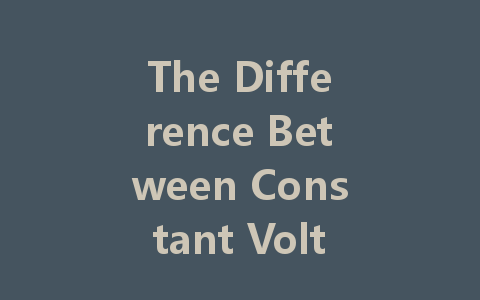LED drivers are essential components in LED lighting systems, ensuring that the LEDs operate efficiently and effectively. Understanding the two primary types of LED drivers—constant voltage and constant current—is crucial for selecting the right driver for your application. This article will delve into the differences between constant voltage and constant current LED drivers, their applications, and considerations for use.
¿Qué es un controlador LED de tensión constante?
A constant voltage LED driver supplies a fixed output voltage to the LED lighting system. This type of driver is commonly used in applications where the LED strips or modules are designed to operate at a specific voltage, typically 12V or 24V. The driver maintains a steady voltage regardless of the load applied, making it suitable for parallel configurations of LED devices.
Características de los controladores LED de tensión constante
¿Qué es un controlador LED de corriente constante?
In contrast, a constant current LED driver maintains a fixed output current to the LED fixtures, adjusting the voltage as needed to ensure the specified current flows through the system. This type of driver is ideal for high-power applications and is commonly used in high-output LED installations such as outdoor lighting and commercial applications.
Características de los controladores LED de corriente constante
Diferencias clave entre tensión constante y corriente constante
Understanding the distinct characteristics of these two types of drivers can be crucial when designing an LED lighting system. Here are the primary differences between constant voltage and constant current LED drivers:
Regulación de tensión frente a regulación de corriente
The fundamental difference lies in what each type of driver regulates. Constant voltage drivers maintain a consistent voltage level, while constant current drivers regulate the output current supplied to the LEDs. This difference significantly impacts the configuration of LEDs in your system.
Idoneidad de la aplicación
Constant voltage drivers are ideal for applications involving LED strips or modules that require a steady voltage, making them popular in residential and decorative lighting. On the other hand, constant current drivers are better suited for high-power applications where maintaining a specific current is crucial for achieving the desired brightness and performance, such as in streetlights or industrial lighting.
Wiring Configurations
Wiring configurations also differ for each type of driver. Constant voltage systems allow for parallel wiring of multiple LED strips, while constant current systems require series wiring to ensure that each LED receives the same current, as the driver adjusts the voltage based on the load.
Cuándo utilizar controladores de tensión constante o de corriente constante
Choosing a Constant Voltage Driver
If your application involves LED strips or fixtures designed for a specific voltage and you need flexibility in configuring multiple devices, a constant voltage driver is your best option. Additionally, if you want ease of installation and the ability to adjust the overall length of lighting without worrying about current limitations, constant voltage drivers are the way to go.
Choosing a Constant Current Driver
For applications where brightness consistency and higher performance are required, such as in commercial or outdoor lighting, a constant current driver is the preferred choice. If you are dealing with high-power LEDs that demand strict current control to ensure their longevity and optimal performance, this driver type is essential.
Conclusión
Both constant voltage and constant current LED drivers play significant roles in the functionality and efficiency of LED lighting systems. Understanding their differences, advantages, and applications allows you to make informed choices for your specific needs. Whether you opt for a constant voltage driver for ease of use or a constant current driver for high performance, ensuring compatibility with your LED fixtures will lead to a successful lighting project.
